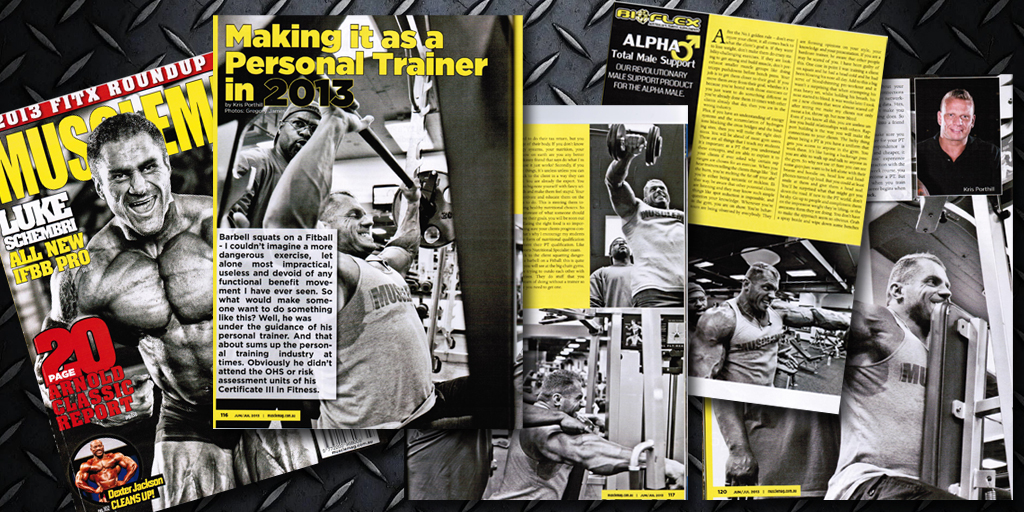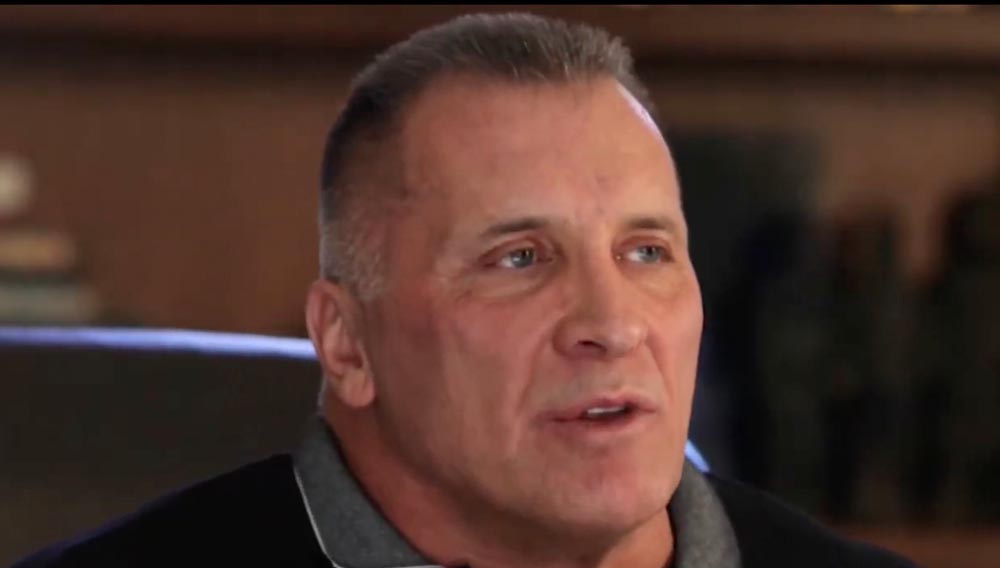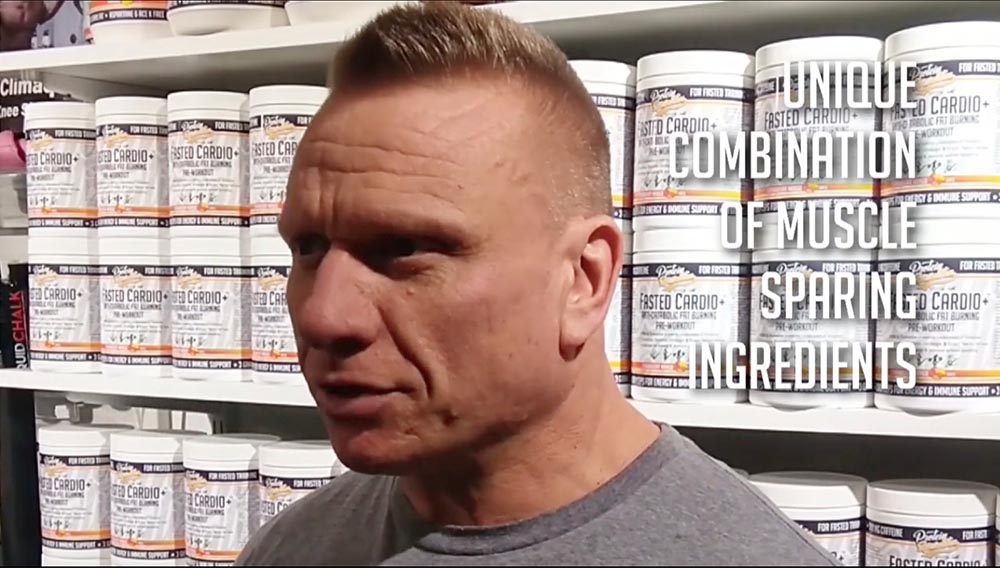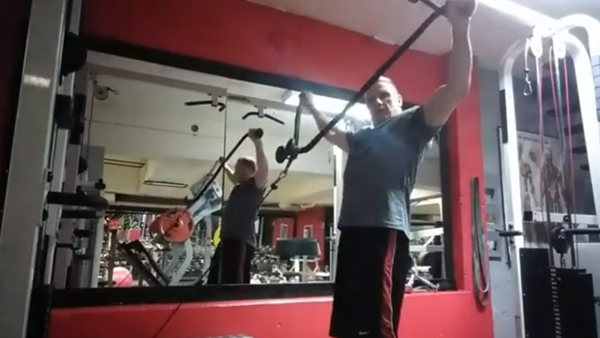Making it as a PT - Muscle Mag 2013
Barbell squats on a fitball, I couldn’t imagine a more dangerous exercise, let alone most impractical, useless and devoid of any functional benefit movement I have ever seen. So what would make someone want to do something like this? Well he was under the guidance of his personal trainer. And that about sums up the personal training industry at times. Obviously he didn’t attend the OHS or risk assessment units of his certificate III in fitness.
I have been working as personal trainer for over 10 years now, in Europe, Asia and Australia. And in my time I have seen it all. Back in the 80’s you were a PT if you trained people in a gym, despite not having any qualifications. As long as you had years of gym experience and a passion and basic understanding of training, you could take on clients. Unfortunately these days, with the explosion in PT courses, people without any real gym experience at all, with little to no understanding of anatomy are walking around claiming to be a PT. I know this first hand. I have been a senior presenter with the AIF, the AIPT and now with the new and innovative WorldPT. I have seen many PT’s graduate fast tracked courses, some great, some not so great. In fact some that are not good at all. PT courses are competency based. Meaning if you pass, you’re deemed competent. Competent in my mind means I can trust you to not walk into a wall. You don’t introduce your girlfriend to your mates or family and say, I’d like you to meet Sally, and she’s competent! Competent is easy. Everyone is competent. You want to be awesome. You want to be confident and amazing.
So what makes an awesome/confident/amazing PT? First and foremost you need to understand anatomy and physiology. You are intrusted in the health of your client. You are not expected to do their tax return, but you are in charge of their body. If you don’t know your energy systems, your nutrition, your anatomy, how on earth are you any better than their skinny friend that says do what I’m doing because it just works. Secondly, if you know these things, it’s useless unless you can relate it back to the client in a way they can understand. You are already the expert. You don’t need to big note yourself with fancy scientific words and make them feel stupid. Your job is to motivate and educate them on the right things to do. This is steering them towards making healthy nutritional choices. So if you are unaware of what someone should eat to achieve their goals, you will be soon out of clients. Eating the right food is so important to making sure your client’s progress consistently. That’s why I encourage my students to get some form of nutritional qualification to complement there PT qualification. Like the ISSN Sports Nutritional Specialist exam.
Getting back to the client squatting dangerously with a barbell on a fit ball. This is quite often what you will see at the big chain gyms. The PT’s are trying to outdo each other with crazy exercises. They do stuff that you wouldn’t dream of doing without a trainer so you feel like you need to get one. After the No.1 golden rule – don’t ever injure your client, it all comes back to what the client’s goal is. If they want to lose weight, don’t make them do crazy stability challenging exercises. If they are looking to get strong and build muscle, don’t pre exhaust smaller muscle groups like doing tricep pushdowns before bench press. Your job is to get them closer to their goal. If you move them away from what their goal, whether it’s because you’re bored with those exercises, or that you just want to do something different as you’ve already done them 10 times with other client’s already that day, then you are in the wrong industry.
Plus if you have an understanding of energy systems and the accumulation of hydrogen ions blocking the cross bridges and the binding sites then you will make the right decisions. You will be ahead of most gym users. These are all things that I teach my students. It’s important as a PT you understand these concepts, and are able to explain it to your clients if ever asked why certain rep ranges are chosen for an exercise. When you hear trainers telling the clients things like “feel the burn, you’re melting the fat off your abs” you’re either being sarcastic or reckless. Either way, be aware that other potential clients are listening and they may know such simple things like spot reduction is impossible, and question your knowledge. Whenever you’re in the gym, you are on show. You’re behaviours are being observed by everybody. They are forming opinions on your style, your knowledge and your presentation. If you are a hard-core trainer, be aware that other people may be scared of you. I have been guilty of this. One case in point I was training a client on squats and he had a head cold and he had been blowing his nose all day. Add to this a big serve of blood thinning pre-workout, it wasn’t a surprising that when attempting his max heavy set, whilst holding his breath, his nose started to bleed. It was weeks later I took on 2 new clients that were almost scared off after seeing me make my client’s not only sweat a lot, throw up, but now bleed.
Even if you know all this, you are useless unless you build relationships with others. Rapport building is the way you will make the connections to your clients. The lucky thing about being a PT is you have a uniform that gets you access to anyone in the gym. You work there. It’s like having a backstage pass, you are able to walk up and talk to anyone in the gym. So why not use it. Sure you can see some guys just want to be left alone with their beanie and hoodie on, head low and headphones turned up loud. But you could at least smile at them and give them a head nod. You’ll be surprised what that might get you down the road. If new to the PT world, don’t be shy. Go up to people and compliment them on the impressive weight they’re lifting, or the awesome form they are doing. You don’t have to make the approach seem so obvious. Grab a spray bottle and wipe down some benches and use that as your “in”. Or pick up some of the weights around them. Make a casual comment and pretty soon the whole gym will know you as a pretty cool trainer that is positive and friendly. If you have never seen a certain exercise a member is performing, ask them about it and what they’re doing it for. Some love the feeling of educating others and an awesome PT is one that knows he has so much more to learn. The old adage of” the more you know, the more you realise you don’t know anything” couldn’t be truer than with PT’s.
Once all that is done, you then need to market yourself. Like Lindy Olsen tells my students in her session on marketing and social media – “business isn’t being done until something is sold.” So you need to market and manage your image/brand. Make sure you know who your target market is and know how to reach them. I have spent so much money on advertising, and most of it was either ineffective and a waste of time and money. Never be anywhere without your business cards and make as many connections with people as possible. Remember, networking is pointless without gathering data. Hits, visits, comments and likes don’t make you money. Interaction and purchasing does. So make sure you turn a follower into a friend and customer.
All those points considered, make sure you chose the right course provider for your PT qualifications. Though correspondence is some times more convenient and cheaper, it pays to have a real “hands on” experience with the teachers and the interaction with the other students. After an 8-10 week course, you are qualified on paper to become a PT. But your real education starts when you train your first session and your career begins when they pay you for it. Good luck




